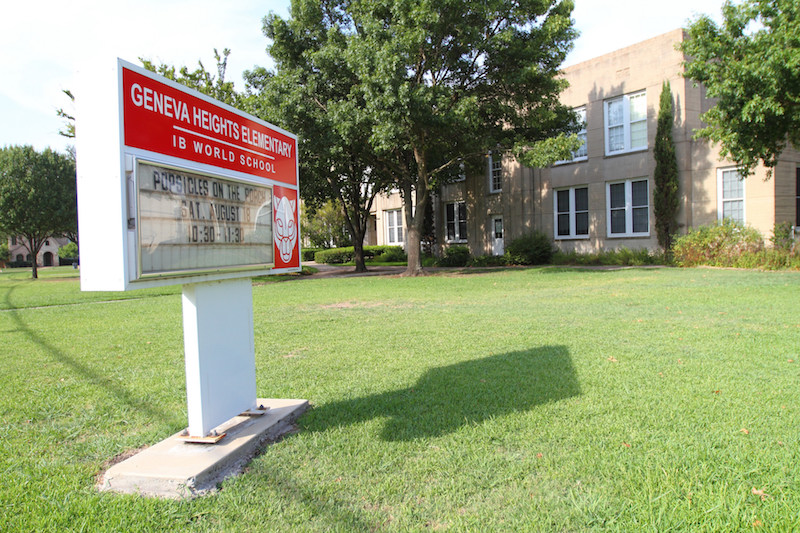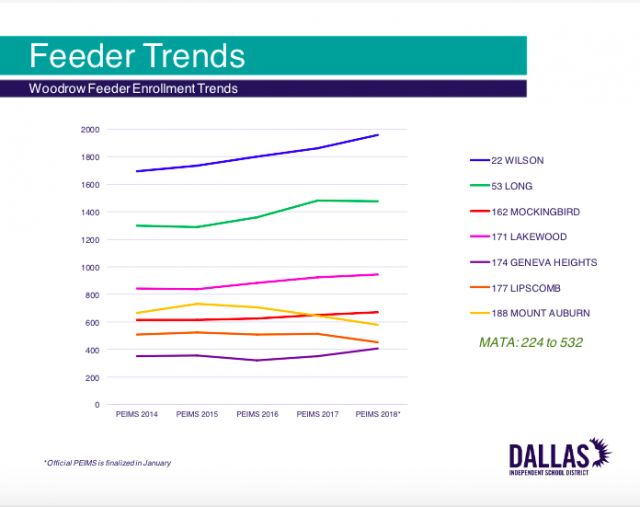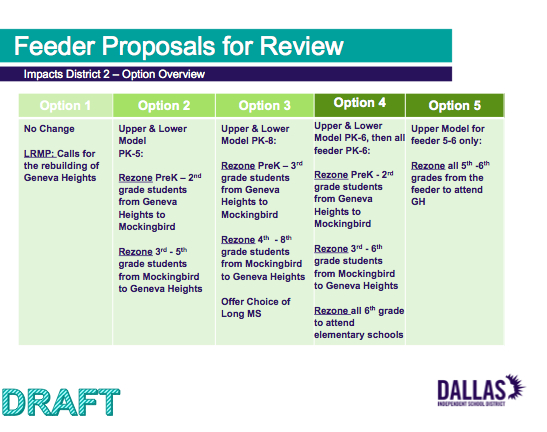
Photo courtesy of Dallas ISD
They gathered at Halcyon, a trendy coffee shop on Lower Greenville, for an espresso-fueled discussion about what schools in East Dallas should look like five, 10, 20 years from now. They knew that the town hall meeting four days away, a few blocks down the road at Geneva Heights Elementary, could be a contentious one.
Many of the fiercest public education advocates in Dallas live in our neighborhood, and sometimes the passion pits one school against another.
Not this time.
On the town hall docket were Dallas ISD’s proposals to consolidate or reconfigure recently renamed Mockingbird and Geneva Heights elementary schools (formerly Stonewall Jackson and Robert E. Lee). Leading up to that night, PTA and site-based decision making committee (SBDM) leaders from those schools as well as sister schools in the Woodrow Wilson High School feeder pattern — Lipscomb, Lakewood and Mount Auburn elementary schools and J.L. Long Middle School — decided the best approach would be a united front.
“They really worked hard to make compromises and look at the big picture instead of just, ‘This is what’s going to work best for my school and my kid,’ ” says Becky Daniel, Woodrow’s SBDM vice-chair and PTA fundraising vice-president. “We sat down and hammered out four viable options we could send back to our school communities and support.”
Dallas ISD officials, thinking toward a possible bond election in 2021, recently rolled out proposals to demolish or replace several campuses across the district, including Geneva Heights.
“Usually we’re scrambling before a bond and then we’re tying to make everyone happy and then no one’s happy,” DISD Chief of School Leadership Stephanie Elizalde told neighbors at the town hall. “This is a little different. [We want to] gather what our needs are in advance.”
Enrollment numbers, population trends and facility conditions led to DISD’s initial suggestions. “However,” Elizalde noted, “emotions are always a part of the decision-making and we get that. There are some contextual factors, which is why we have to come to the community.”

Driving the proposals were several factors:
• Geneva Heights, built as Robert E. Lee Elementary in 1931, is the third worst in the district (tied with Rosemont Elementary in Oak Cliff), according to the district’s facility condition index. DISD says that it would need to invest 91 percent of the building’s total cost in order to keep Geneva Heights in working order.
• Student enrollment at Woodrow, Long, Lakewood and Mockingbird has increased over the past several years, while enrollment at Mount Auburn and Lipscomb has declined, partly because of gentrification in those attendance zones.
• Lakewood and Mockingbird, both of which just opened additions, are only a few students away from filling their new buildings, and Long and Woodrow both are overcrowded.
• Geneva Heights’ student enrollment is climbing slowly, thanks to efforts of current parents and the Pre-Geneva early childhood PTA, with its 200-plus members generating interest in the school. But the school still is the emptiest in the feeder, only 64 percent full.

Dallas ISD presented five possibilities to the community, which boil down to:
1. Replace Geneva Heights. (District 2 Trustee Dustin Marshall says he has “made it clear” to DISD administration “that we need to preserve the architectural and historical significance of the Geneva Heights building. The Administration has agreed that any potential future construction would only gut the interior of the structure and would leave the exterior predominately intact (except as needed to accommodate additions to the building — much like we did with Long and Woodrow).”)
2. Make Mockingbird a pre-K through second-grade school and Geneva Heights a third- through fifth-grade school, and combine the schools’ populations.
3. Make Mockingbird a pre-K through third-grade school and Geneva Heights a fourth- through eighth-grade school, and combine the schools’ populations.
4. Make Mockingbird a pre-K through second-grade school and Geneva Heights a third- through sixth-grade school, combine those schools’ populations, and move all sixth-graders from Long back to their elementary schools.
5. Send all fifth- and sixth-graders in the Woodrow feeder pattern to Geneva Heights.

When PTA and SBDM parents from the various schools came together to discuss the options, the “best-case scenario,” in their view, was DISD’s option 1 — build a new Geneva Heights.
But if that option loses traction for enrollment or financial reasons, they told Marshall in an email that they believe their school communities would support DISD’s option 5 of turning Geneva Heights into a fifth- and sixth-grade center — a “similar model to HPISD” — and Geneva Heights students in pre-K through fourth-grade “could choose to attend either Mockingbird or Lipscomb based on curricula choice and space available.”
Or, they would support DISD’s option 2, but flipped — “Mockingbird becomes grades three through five to accommodate the science curricula tied to the garden, etc.”
They also tossed in a new idea, to turn Lipscomb into a pre-K center for the Woodrow feeder pattern’s 3- and 4-year-olds. Then, the new Geneva Heights would house Lipscomb kindergarten through fifth-graders, too.
The only real sacred cow, Daniel says, was for “kids to be together in seventh through 12th grade,” starting the year that Texas University Interscholastic League (UIL) begins.
Dallas ISD proposed a middle school option because “many parents like a smaller familiar environment for middle school” that “provides a comfortable transition place.” The parents who came up with counter-proposals, however, felt like a fifth- and sixth-grade center could provide this transition.
“On the whole, people want their kids in the same place for elementary school. They want that continuity,” Daniel says. But “fifth-graders are a little bit big for their britches. They’re ready to go and spread their wings, and sixth-graders aren’t mature enough to be with eighth-graders.” The downside, says Alex Enriquez, Lipscomb’s SBDM chair, is that while “everyone’s excited about an intermediate center, nobody wants to lose their neighborhood school.”
The reality, Enriquez says, is that “the plans we are talking about would not affect any of the kids in school today.” Marshall, at the town hall’s onset, emphasized that “this is very much the beginning stage of a lengthy dialogue.” He added that DISD has been “rightly accused of making decisions in closed rooms without community input, and this is the first of many steps to avoid doing that in the Woodrow feeder pattern.”
“We all know there’s not a win-win solution, but there are best-case scenarios,” Daniel says. Parents who live in East Dallas “believe in public schools and want their kid to have a great experience, and the best way to do that is to have great schools with diverse people,” she says.
“We all had our own preferences, our own interests and our own perspectives,” Enriquez says. “Not everyone left thinking, ‘This is going to be great for my neighborhood’ — but it’s going to be great for the overall neighborhood.”





